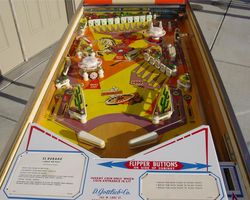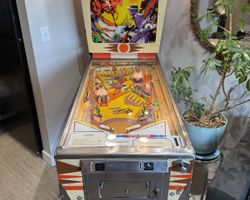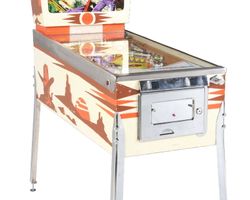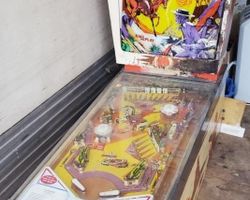El Dorado

Average Prices: USD $700 to $2,100
Produced: April, 1975
Production Run: 2,875 units
Machine Type: Electro-mechanical
Players: 1
Design by: Ed Krynski
Art by: Gordon Morison
The pinball machine "El Dorado" from D. Gottlieb & Co., released in April 1975, emerged during a pivotal period for electro-mechanical (EM) pinball. Gottlieb, a dominant force in the industry, was known for producing highly playable and durable machines. "El Dorado" was designed by Ed Krynski, a prolific and influential figure in pinball design, with artwork rendered by Gordon Morison. Morison's artistic vision brought the machine's distinct Western theme to life, integrating elements of the American frontier into the playfield and cabinet aesthetics. The theme of exploration and pursuit of fortune, evocative of the mythical lost city of gold, resonated with players seeking both challenge and reward.
The production run for "El Dorado" totaled 2,875 units, a solid number for an EM title of its era, indicating confidence in its appeal. Its design marked a continuation of Gottlieb's successful EM formula while introducing specific innovations. A notable aspect of its development was the strategic reuse of its acclaimed playfield design across multiple subsequent Gottlieb titles. This core layout formed the basis for several variations, including the 1-player replay version "El Dorado" itself, the add-a-ball version "Gold Strike," an Italian add-a-ball variant "Lucky Strike," the 4-player replay "Target Alpha," the 4-player French exclusive "Canada Dry," and the 2-player replay "Solar City." This shared heritage underscores the strength and versatility of the underlying design. Later, Premier, under different ownership, would release "El Dorado City of Gold" in 1984, further testament to the enduring appeal of this playfield. Interestingly, Gottlieb's 1978 parts catalog indicated a slight difference in slingshot rubber ring sizes between "El Dorado" and its 4-player counterparts, a subtle detail reflecting minor manufacturing adaptations between models.
"El Dorado" distinguishes itself with a suite of features that contribute to its gameplay depth. Central to its allure are the fifteen drop targets strategically placed across the playfield. This abundance includes a prominent 10-bank of targets and a separate 5-bank, many of which feature unique artwork depicting cacti and horses, seamlessly integrating with the Western theme. The act of clearing these banks provides both score incentives and satisfying tactile feedback. Another significant feature is the inclusion of four flippers: two standard flippers at the bottom of the playfield and two smaller, upper mini-flippers positioned higher up. This configuration expands the range of shot opportunities and demands precise ball control.
Further enhancing the dynamic play, "El Dorado" incorporates two pop bumpers and two slingshots, which inject unpredictable energy into ball movement. A unique and challenging element is the pair of moving 5,000-point targets. These targets add a dynamic layer to gameplay, requiring precise timing and anticipation to hit them for maximum value. Their movement transforms static target shooting into a more engaging, skill-based endeavor. The classic Gottlieb chimes provide a distinct auditory experience, punctuating shots and scoring milestones with their resonant tones. This combination of numerous targets, varied flipper options, and interactive elements defines the machine's signature appeal, drawing players into its captivating Western frontier.
The playfield of "El Dorado" presents an asymmetrical layout, a design choice that contributes to its renowned flow and challenge. From the plunger, the ball enters the upper playfield, where two rollover lanes offer initial scoring opportunities. The two upper mini-flippers are positioned to allow shots at the upper sections of the 10-bank drop targets or to direct the ball towards the pop bumpers. The 10-bank itself is a primary objective, spread across the mid-playfield, inviting multiple shots from various angles. Below this, the two pop bumpers are situated to create chaotic ball deflections, often feeding the ball into the lower half of the playfield or back towards the flippers.
The lower half of the playfield houses the two main flippers, which provide powerful shots across the open layout. Strategic shots from these flippers are crucial for hitting the lower portions of the 10-bank targets, the 5-bank targets located to the side, and the two standup targets. The 5-bank of drop targets, often angled, requires accurate aiming. The moving 5,000-point targets are typically positioned within the lower playfield, demanding players time their shots as these targets traverse their path. The open design philosophy promotes a fast, fluid game experience, rewarding players who can maintain ball control and execute precise shots. Visually, Gordon Morison's artwork saturates the playfield with Western motifs, from the detailed cacti and horses on the drop targets to the scenic backglass, creating a cohesive aesthetic that fully immerses the player in the machine's theme. The lighting, typical of EM machines, highlights key scoring areas and objectives, guiding the player's attention during play.
Gameplay on "El Dorado" centers on a clear progression tied to its abundant drop targets. The primary objective is to knock down all targets in a bank to earn points and, crucially, to activate the target reset feature for potential special awards. Hitting the 10-bank drop targets offers significant points, and clearing the entire bank often resets them, providing a fresh challenge and opportunities for bonus multipliers. Similarly, the 5-bank drop targets contribute to scoring and overall game progression. The moving 5,000-point targets introduce a dynamic element, requiring players to time their shots precisely as they move across the playfield, offering a higher point value than static targets. Beyond the targets, rolling over specific lanes awards points and contributes to bonus scoring.
The core gameplay loop involves skillfully clearing target banks, aiming for high-value moving targets, and utilizing the four flippers to control the ball's movement and set up subsequent shots. A key gameplay highlight is the strategic satisfaction derived from clearing all targets across the playfield, which often illuminates a special, rewarding a free game. This pursuit encourages "one more game" sessions as players strive to achieve this satisfying objective. Strategies often involve using the powerful lower flippers to aim for the larger target banks or to send the ball to the upper playfield where the mini-flippers can direct it towards the more challenging upper targets or activate the pop bumpers for unpredictable scoring. The interplay between precision shooting and managing the unpredictable bounces from the pop bumpers defines the rhythmic challenge and rewarding nature of "El Dorado."
"El Dorado" generally garners considerable acclaim within the pinball community, often cited as a benchmark electro-mechanical machine. Its strengths are frequently highlighted, particularly its extensive array of fifteen drop targets, which provide engaging and satisfying gameplay. The playfield layout is frequently described as superb and challenging, yet accessible, striking an effective balance that appeals to players of varying skill levels. Many enthusiasts consider it a highly addictive machine due to its fast, fluid gameplay and the rewarding nature of its target-oriented ruleset. The distinct Gottlieb chimes are consistently praised for enhancing the auditory experience, complementing the Western theme that is generally regarded as cohesive and well-executed. The presence of four flippers is also seen as a positive differentiator, offering expanded shot opportunities. The ruleset, for an EM game, is often deemed excellent, focusing on intuitive objectives like rollovers and the dynamic moving targets.
Despite this strong positive reception, "El Dorado" does receive some nuanced feedback. A minority of players suggest that gameplay can become repetitive over extended sessions, focusing predominantly on clearing drop targets. While the artwork is broadly appreciated, a few express a desire for more vibrant colors on the cabinet art. A small number of players, having heard significant praise for the machine, found its actual play experience to be less exhilarating than their heightened expectations. Specific criticisms include one reviewer finding the skill shot to be less engaging than desired, and another noting that the upper mini-flippers could lose utility once certain upper targets were cleared. Additionally, due to its status as a desirable classic, some observers consider "El Dorado" to be relatively overpriced in the vintage pinball market.
Its legacy is robust; "El Dorado" is often recommended as a "keeper" or a "must-own" for collectors focusing on EM machines. Its successful playfield design influenced Gottlieb's subsequent four-player titles, including "Target Alpha," which reused the core layout, demonstrating the enduring quality of its fundamental design. Its status as one of Gottlieb's most highly regarded EM machines contributes to its continued relevance and desirability in pinball history.
Sponsored Links
 Ebay Listings
Ebay Listings
 Auction Results
Auction Results
| Cost | Location | Date |
|---|---|---|
| USD $1,500 |  Minnesota, United States Minnesota, United States |
16 July, 2025 |
| USD $1,300 |  Iowa, United States Iowa, United States |
10 June, 2025 |
| CAD $410 |  Canada Canada |
07 May, 2025 |
| GBP £650 |  United Kingdom United Kingdom |
18 January, 2025 |
| USD $450 |  Kentucky, United States Kentucky, United States |
01 June, 2024 |
| USD $1,500 |  Maryland, United States Maryland, United States |
13 May, 2024 |
| USD $640 |  Texas, United States Texas, United States |
31 March, 2023 |
| USD $1,030 |  Wyoming, United States Wyoming, United States |
26 March, 2023 |
| USD $2,500 |  California, United States California, United States |
18 March, 2023 |
| USD $1,600 |  Pennsylvania, United States Pennsylvania, United States |
05 November, 2022 |


Private Policy · Search Website · Contact Us
As an eBay Partner, we may earn a commission from qualifying purchases made through links on this site, at no additional cost to you.
All trademarks and copyrighted materials remain property of their respective owners. All other content copyright 2007 - 2025 Pinpedia.







